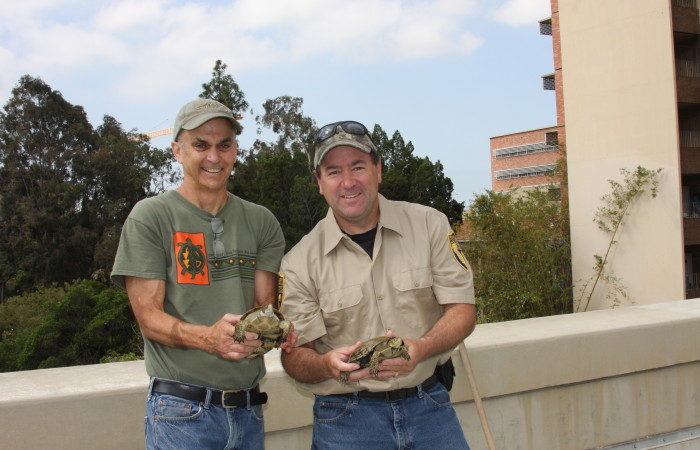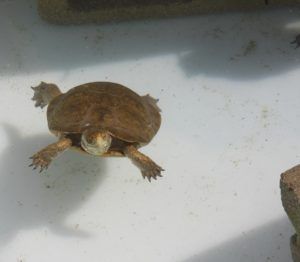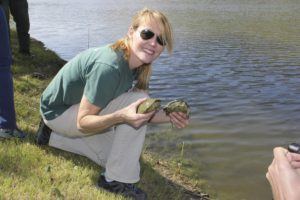
Blog |
Team Turtle Beats the Drought
A population of 28 genetically significant turtles whose California habitat was threatened by the state’s ongoing drought has been released into a new ecosystem after their rescue by IoES ecologists, UCLA Environmental Science students, and partners.
“It seemed pretty clear they would all be dead if we did not step in and take action,” says IoES conservation biologist Brad Shaffer about the Southwestern Pond Turtles, California’s only native freshwater turtle and the only population that is a natural hybrid between the northern and southern species of turtle.
IoES faculty, students, and research staff affiliated with the UCLA La Kretz Center for California Conservation Science helped saved the turtles last year from their imperiled habitat at drought-stricken Elizabeth Lake in northwest Los Angeles County. After living eight months in captivity, they were released into the wild in May.
Necessity of the Rescue
It was almost exactly a year ago when the California Department of Fish and Wildlife (CDFW) reached out to the La Kretz Center and Turtle Conservancy’s Behler Chelonian Center about working together to save this genetically unique population. (Read the original story here).
“When the turtles were collected they were undernourished, dehydrated, and in poor health,” explains Tim Hovey of the CDFW. Much of their condition, he adds, was likely due to extremely bad water quality in the lake, which negatively influenced their food base, and the encrusting of their shells, which impacted their ability to thermal regulate (warm up).
 The 28 turtles were relocated to pools set up on the roof of UCLA’s Botany Building and received hands-on care from La Kretz Center experts and Environmental Science seniors. Shaffer says the students were instrumental in keeping the turtles healthy and well-fed.
The 28 turtles were relocated to pools set up on the roof of UCLA’s Botany Building and received hands-on care from La Kretz Center experts and Environmental Science seniors. Shaffer says the students were instrumental in keeping the turtles healthy and well-fed.
“They did a lot of the feeding and cleaning,” he notes, “especially after the first couple of months.”
The turtles were fed three times per week and given their own cinder block “homes.” They readily adapted, basking a lot and gaining weight, and increased in health without becoming too acclimated to people.
“All of this care was critical to getting them prepared to go back in the wild,” says Shaffer.
“We ultimately decided that a spring release, while they still could mate, lay eggs, and prepare for the following winter, was the best strategy for the reintroduction.”
Return to the Wild
Because it didn’t rain much last winter, the scientists had concerns that the original Elizabeth Lake home had not improved enough for the turtles and would possibly deteriorate further.
CDFW officials were able to reach an agreement with The Painted Turtle facility located only a mile upstream from Elizabeth Lake. An innovative camp program located near the town of Lake Elizabeth in Lake Hughes, California, The Painted Turtle caters to children with serious illnesses.
The facility is also ideal for actual turtles: Not only does it pump water to pools and ponds that serve as recreational spots, it has basking areas and quality upland habitats.
 After more than half a year recuperating in tanks overlooking the campus’s botanical garden, the UCLA turtles (plus members of their population cared for by the partner organizations) were transported to the release facility. They were carried to the bank of the largest pond at The Painted Turtle and placed a foot from the water. All quickly entered the pond and swam off.
After more than half a year recuperating in tanks overlooking the campus’s botanical garden, the UCLA turtles (plus members of their population cared for by the partner organizations) were transported to the release facility. They were carried to the bank of the largest pond at The Painted Turtle and placed a foot from the water. All quickly entered the pond and swam off.
Promoting conservation science and action
Shaffer says this effort reflects the La Kretz Center’s most fundamental mission — to protect and preserve California’s biodiversity. Every turtle was marked with a Passive Integrated Transponder tag so the scientists can track individuals and their offspring. Shaffer says they intend to continue with follow-up work on the population.
“It is clear that captive management, including captive breeding, will increasingly be a part of endangered species management in the future, especially for populations that are isolated and fragmented by human development,” he adds.
“If such actions become necessary for survival, then we at UCLA are ready to work with agency partners to help out.”
